Abstract
Iron overload causes inhibition of hepatic uroporphyrinogen decarboxylase (UROD) and uroporphyria in C57BL/10ScSn but not DBA/2 mice [Smith, Cabral, Carthew, Francis and Manson (1989) Int. J. Cancer 43, 492-496]. We have investigated the induction of uroporphyria in 12 inbred strains of mice 25 weeks after iron treatment (600 mg/kg) to determine if there was any correlation with the Ah locus. Under these conditions, inhibition of UROD occurred to varying degrees in Ahd mice (SWR and AKR) as well as nominally Ahb-1 (C57BL/6J, C57BL/10ScSn and C57BL/10-cc) and Ahb-2 strains (BALB/c and C3H/HeJ). Five other Ahb or Ahd strains (C57BL/Ks, A/J, CBA/J, LP and DBA/2) were unaffected. Thus there appeared to be no correlation with the Ah phenotype and this illustrated that some other variable inherited factors are involved. Comparisons between another susceptible strain, A2G, and the congenic A2G-hr/+strain (carrying the recessive hr gene) showed a modulating influence associated with the hr locus. In contrast with individual mice of inbred strains, which showed consistent responses to iron, those of the outbred MF1 strain showed a spectrum of sensitivities as might be expected for a heterogeneic stock. The rate of porphyria development was accelerated by administration of 5-aminolaevulinic acid (5-ALA) in the drinking water, but this did not overcome strain differences. Among four strains the order of susceptibility was SWR > C57BL/10ScSn > C57B1/6J > DBA/2 (the last strain was completely resistant). With degrees of iron loading greater than 600 mg of Fe/kg (1200-1800 mg of Fe/kg) C57BL/10ScSn mice (after 20 weeks) and SWR mice (after 5 weeks which included 4 weeks of 5-ALA treatment) had less inhibition of UROD and a lower uroporphyric response, showing that there was an optimum level of liver iron concentration. Studies on selected microsomal enzyme activities associated with cytochrome P-450 showed no correlation with the propensities of strains to develop porphyria. These activities included the NADPH-dependent oxidation of uroporphyrinogen I to uroporphyrin I.
Full text
PDF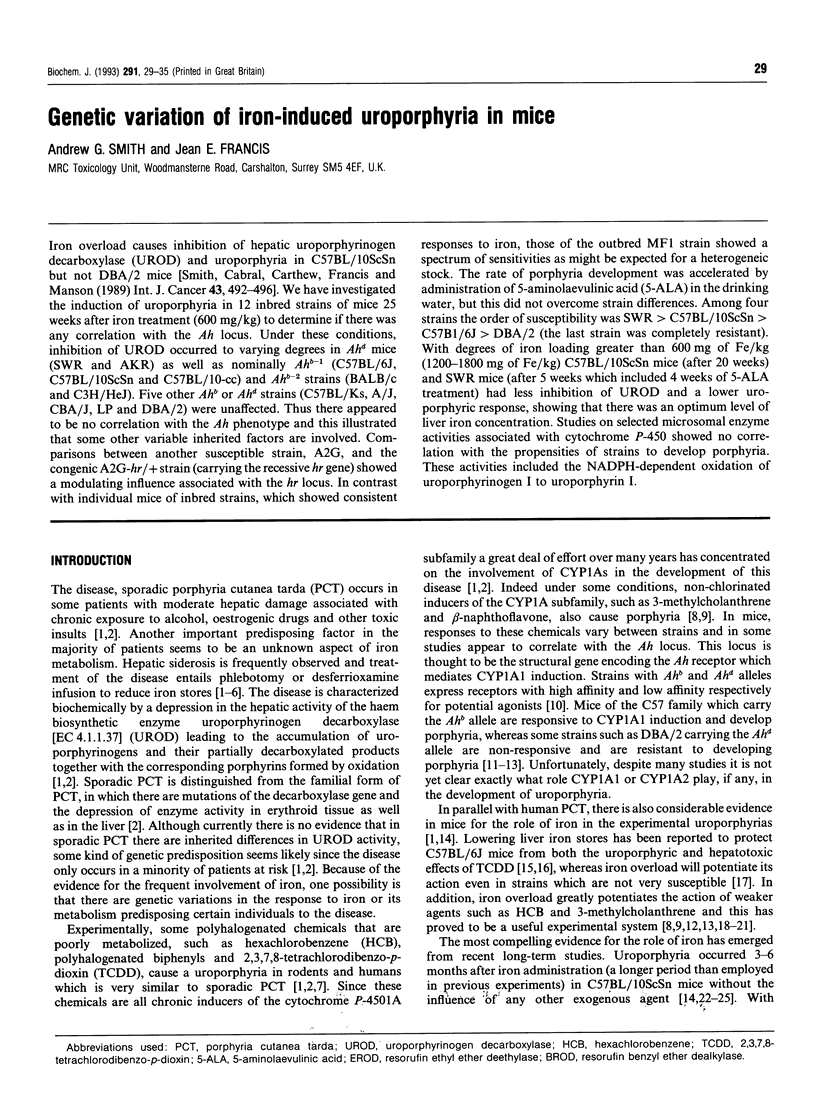
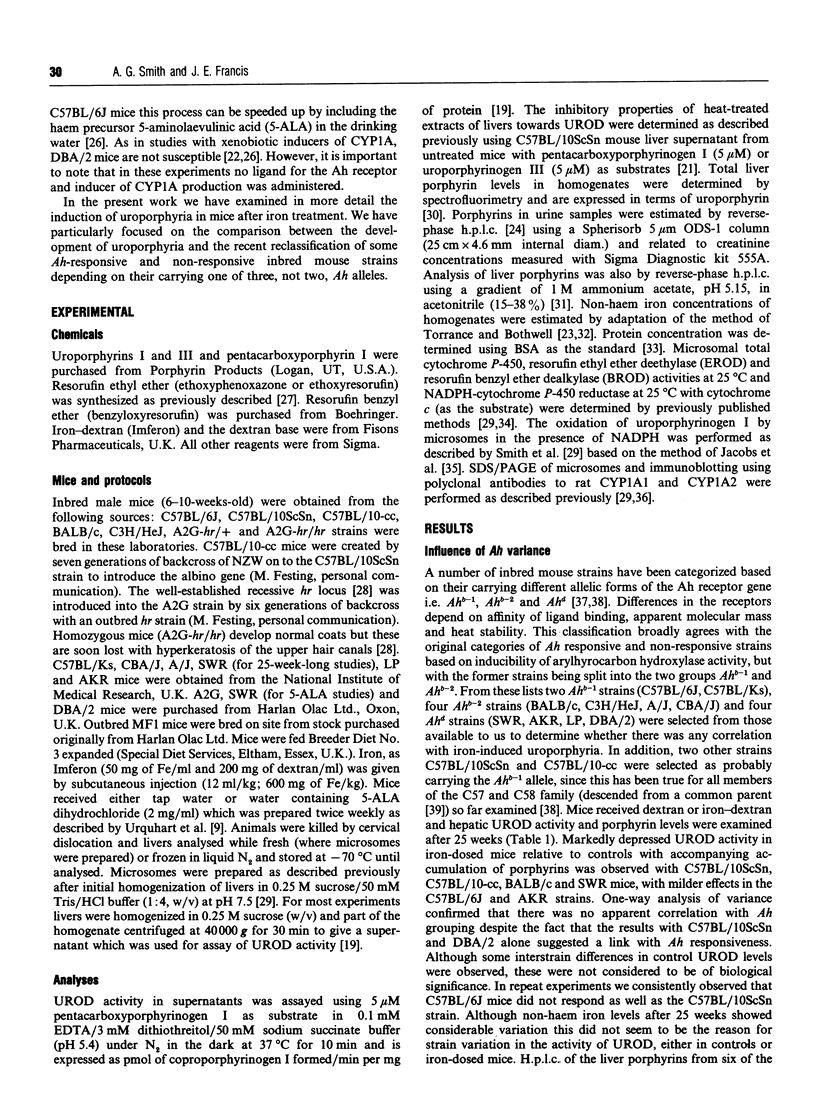
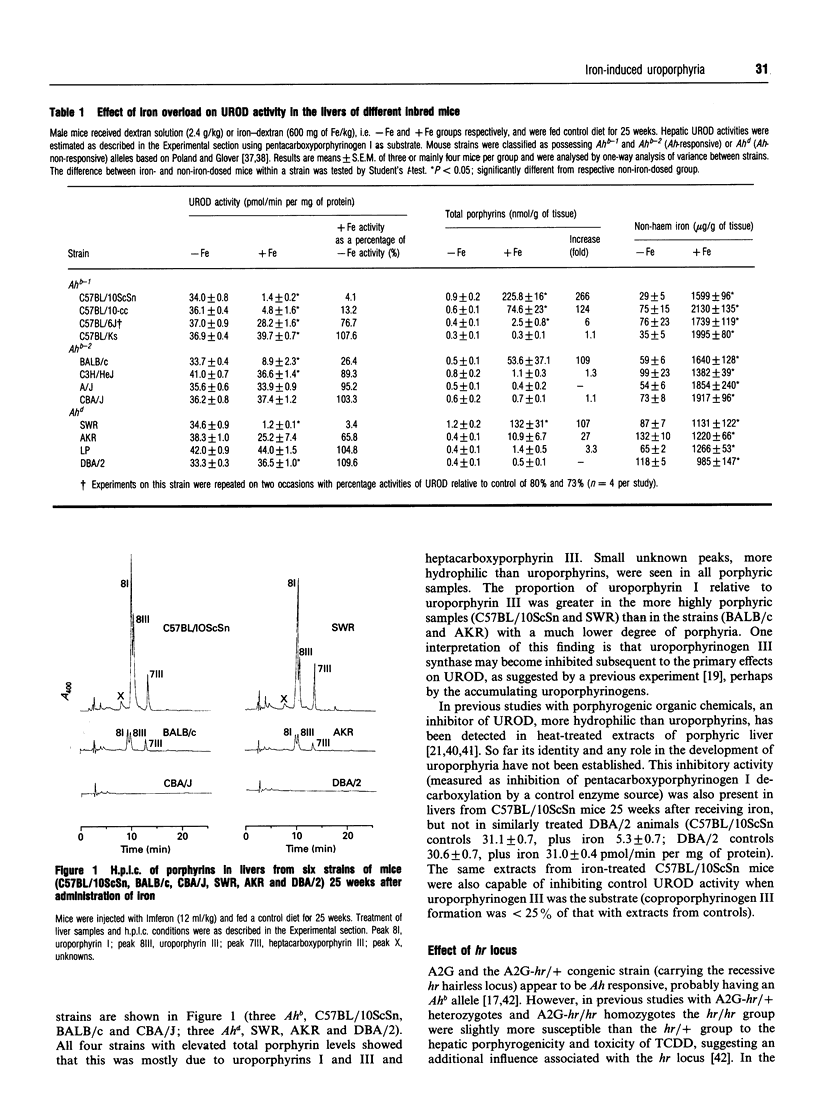
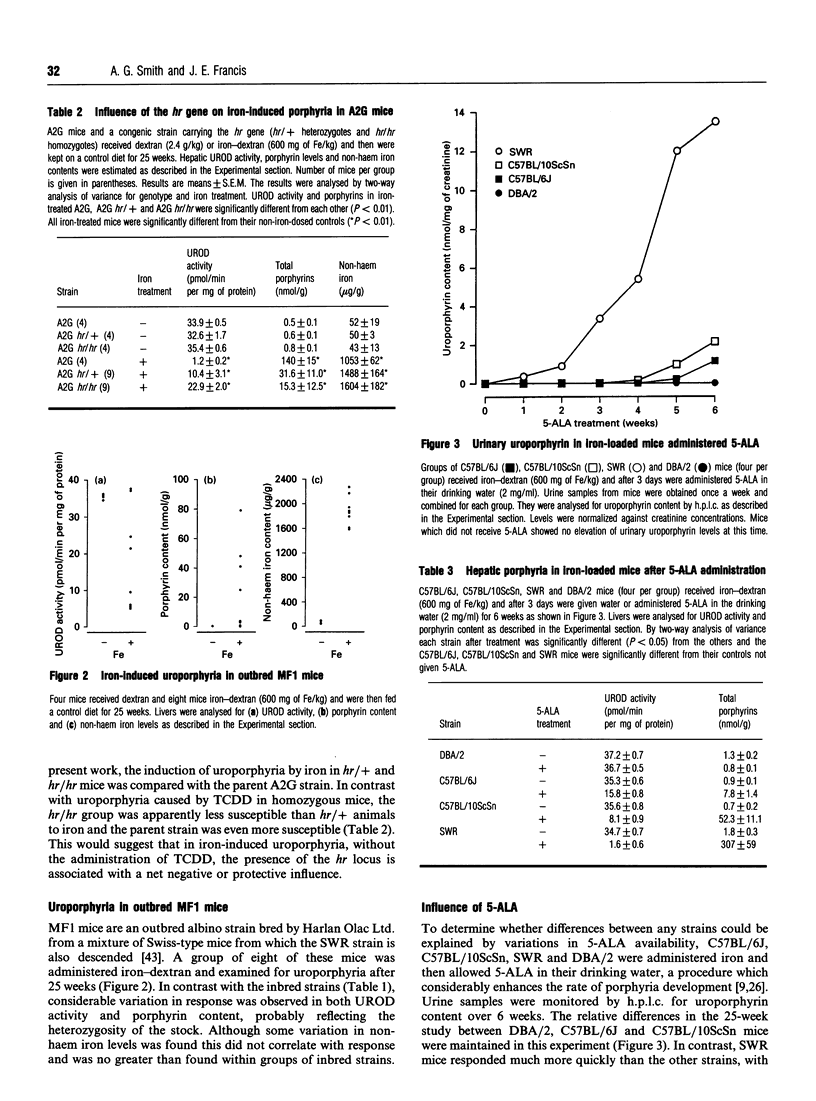
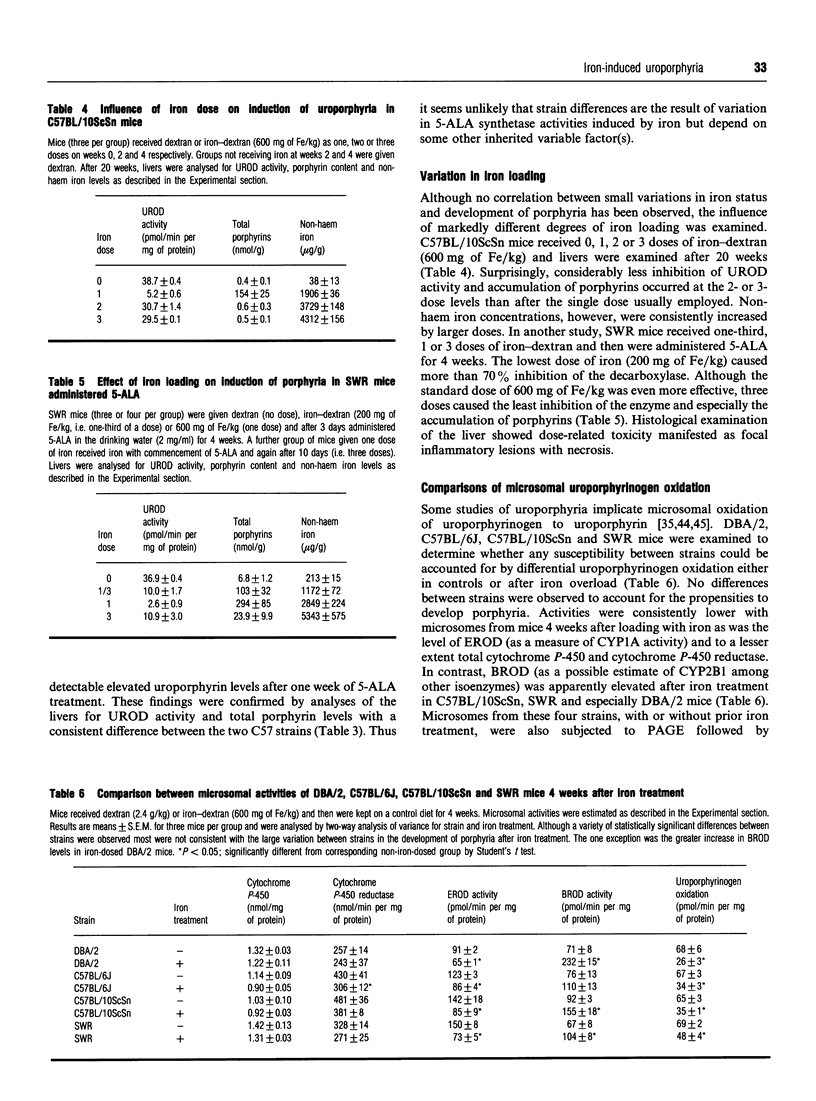
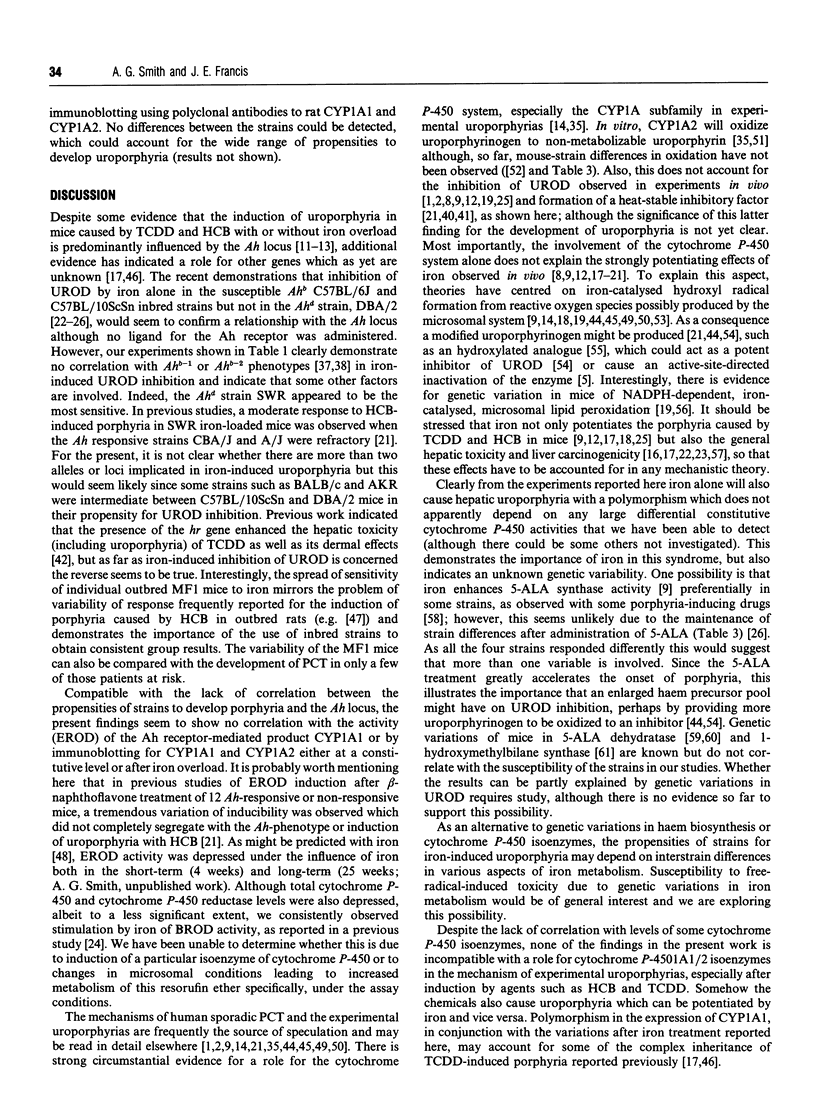
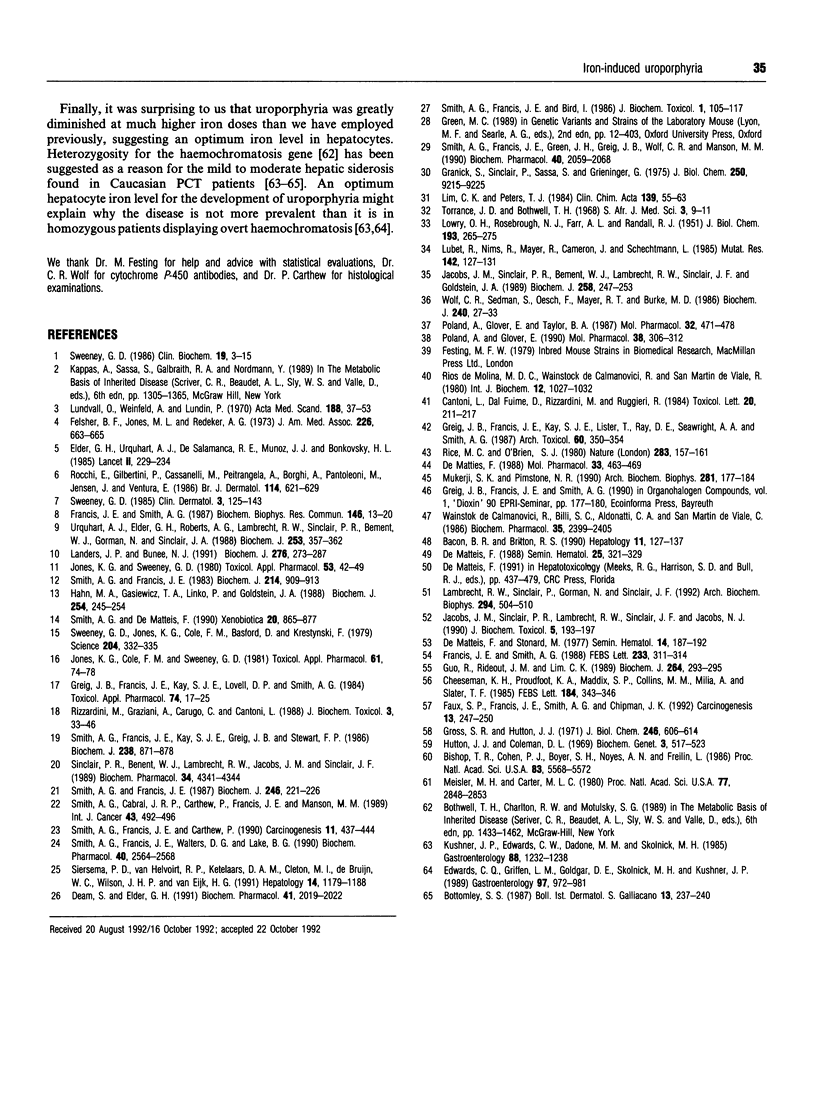
Selected References
These references are in PubMed. This may not be the complete list of references from this article.
- Bacon B. R., Britton R. S. The pathology of hepatic iron overload: a free radical--mediated process? Hepatology. 1990 Jan;11(1):127–137. doi: 10.1002/hep.1840110122. [DOI] [PubMed] [Google Scholar]
- Bishop T. R., Cohen P. J., Boyer S. H., Noyes A. N., Frelin L. P. Isolation of a rat liver delta-aminolevulinate dehydrase (ALAD) cDNA clone: evidence for unequal ALAD gene dosage among inbred mouse strains. Proc Natl Acad Sci U S A. 1986 Aug;83(15):5568–5572. doi: 10.1073/pnas.83.15.5568. [DOI] [PMC free article] [PubMed] [Google Scholar]
- Cantoni L., dal Fiume D., Rizzardini M., Ruggieri R. In vitro inhibitory effect on porphyrinogen carboxylyase of liver extracts from TCDD treated mice. Toxicol Lett. 1984 Feb;20(2):211–217. doi: 10.1016/0378-4274(84)90149-8. [DOI] [PubMed] [Google Scholar]
- Cheeseman K. H., Proudfoot K. A., Maddix S. P., Collins M. M., Milia A., Slater T. F. Low rate of NADPH/ADP-iron dependent lipid peroxidation in hepatic microsomes of DBA/2 mice. FEBS Lett. 1985 May 20;184(2):343–346. doi: 10.1016/0014-5793(85)80635-9. [DOI] [PubMed] [Google Scholar]
- De Matteis F. Role of iron in the hydrogen peroxide-dependent oxidation of hexahydroporphyrins (porphyrinogens): a possible mechanism for the exacerbation by iron of hepatic uroporphyria. Mol Pharmacol. 1988 Apr;33(4):463–469. [PubMed] [Google Scholar]
- De Matteis F., Stonard M. Experimental porphyrias as models for human hepatic porphyrias. Semin Hematol. 1977 Apr;14(2):187–192. [PubMed] [Google Scholar]
- De Matteis F. Toxicological aspects of liver heme biosynthesis. Semin Hematol. 1988 Oct;25(4):321–329. [PubMed] [Google Scholar]
- Deam S., Elder G. H. Uroporphyria produced in mice by iron and 5-aminolevulinic acid. Biochem Pharmacol. 1991 Jun 15;41(12):2019–2022. doi: 10.1016/0006-2952(91)90144-t. [DOI] [PubMed] [Google Scholar]
- Edwards C. Q., Griffen L. M., Goldgar D. E., Skolnick M. H., Kushner J. P. HLA-linked hemochromatosis alleles in sporadic porphyria cutanea tarda. Gastroenterology. 1989 Oct;97(4):972–981. doi: 10.1016/0016-5085(89)91506-0. [DOI] [PubMed] [Google Scholar]
- Elder G. H., Urquhart A. J., De Salamanca R. E., Munoz J. J., Bonkovsky H. L. Immunoreactive uroporphyrinogen decarboxylase in the liver in porphyria cutanea tarda. Lancet. 1985 Aug 3;2(8449):229–233. doi: 10.1016/s0140-6736(85)90287-9. [DOI] [PubMed] [Google Scholar]
- Faux S. P., Francis J. E., Smith A. G., Chipman J. K. Induction of 8-hydroxydeoxyguanosine in Ah-responsive mouse liver by iron and Aroclor 1254. Carcinogenesis. 1992 Feb;13(2):247–250. doi: 10.1093/carcin/13.2.247. [DOI] [PubMed] [Google Scholar]
- Felsher B. F., Jones M. L., Redeker A. G. Iron and hepatic uroporphyrin synthesis. Relation in porphyria cutanea tarda. JAMA. 1973 Nov 5;226(6):663–665. [PubMed] [Google Scholar]
- Francis J. E., Smith A. G. Oxidation of uroporphyrinogens by hydroxyl radicals. Evidence for nonporphyrin products as potential inhibitors of uroporphyrinogen decarboxylase. FEBS Lett. 1988 Jun 20;233(2):311–314. doi: 10.1016/0014-5793(88)80449-6. [DOI] [PubMed] [Google Scholar]
- Francis J. E., Smith A. G. Polycyclic aromatic hydrocarbons cause hepatic porphyria in iron-loaded C57BL/10 mice: comparison of uroporphyrinogen decarboxylase inhibition with induction of alkoxyphenoxazone dealkylations. Biochem Biophys Res Commun. 1987 Jul 15;146(1):13–20. doi: 10.1016/0006-291x(87)90683-8. [DOI] [PubMed] [Google Scholar]
- Greig J. B., Francis J. E., Kay S. J., Lister T., Ray D. E., Seawright A. A., Smith A. G. Pleiotropic effect of the gene hairless on hepatotoxicity of 2, 3, 7, 8-tetrachlorodibenzo-p-dioxin in mice. Arch Toxicol. 1987 Jul;60(5):350–354. doi: 10.1007/BF00295754. [DOI] [PubMed] [Google Scholar]
- Greig J. B., Francis J. E., Kay S. J., Lovell D. P., Smith A. G. Incomplete correlation of 2,3,7,8-tetrachlorodibenzo-p-dioxin hepatotoxicity with Ah phenotype in mice. Toxicol Appl Pharmacol. 1984 Jun 15;74(1):17–25. doi: 10.1016/0041-008x(84)90265-5. [DOI] [PubMed] [Google Scholar]
- Gross S. R., Hutton J. J. Induction of hepatic delta-aminolevulinic acid synthetase activity in strains of inbred mice. J Biol Chem. 1971 Feb 10;246(3):606–614. [PubMed] [Google Scholar]
- Guo R., Rideout J. M., Lim C. K. Identification of meso-hydroxyuroporphyrin I in the urine of a patient with congenital erythropoietic porphyria. Biochem J. 1989 Nov 15;264(1):293–295. doi: 10.1042/bj2640293. [DOI] [PMC free article] [PubMed] [Google Scholar]
- Hahn M. E., Gasiewicz T. A., Linko P., Goldstein J. A. The role of the Ah locus in hexachlorobenzene-induced porphyria. Studies in congenic C57BL/6J mice. Biochem J. 1988 Aug 15;254(1):245–254. doi: 10.1042/bj2540245. [DOI] [PMC free article] [PubMed] [Google Scholar]
- Hutton J. J., Coleman D. L. Linkage analyses using biochemical variants in mice. II. Levulinate dehydratase and autosomal glucose 6-phosphate dehydrogenase. Biochem Genet. 1969 Oct;3(5):517–523. doi: 10.1007/BF00485612. [DOI] [PubMed] [Google Scholar]
- Jacobs J. M., Sinclair P. R., Bement W. J., Lambrecht R. W., Sinclair J. F., Goldstein J. A. Oxidation of uroporphyrinogen by methylcholanthrene-induced cytochrome P-450. Essential role of cytochrome P-450d. Biochem J. 1989 Feb 15;258(1):247–253. doi: 10.1042/bj2580247. [DOI] [PMC free article] [PubMed] [Google Scholar]
- Jacobs J. M., Sinclair P. R., Lambrecht R. W., Sinclair J. F., Jacobs N. J. Role of inducer binding in cytochrome P-450 IA2-mediated uroporphyrinogen oxidation. J Biochem Toxicol. 1990 Fall;5(3):193–199. doi: 10.1002/jbt.2570050310. [DOI] [PubMed] [Google Scholar]
- Jones K. G., Cole F. M., Sweeney G. D. The role of iron in the toxicity of 2,3,7,8-tetrachlorodibenzo-(p)-dioxin (TCDD). Toxicol Appl Pharmacol. 1981 Oct;61(1):74–88. doi: 10.1016/0041-008x(81)90009-0. [DOI] [PubMed] [Google Scholar]
- Jones K. G., Sweeney G. D. Dependence of the porphyrogenic effect of 2,3,7,8-tetrachlorodibenzo(p)dioxin upon inheritance of aryl hydrocarbon hydroxylase responsiveness. Toxicol Appl Pharmacol. 1980 Mar 30;53(1):42–49. doi: 10.1016/0041-008x(80)90379-8. [DOI] [PubMed] [Google Scholar]
- Kushner J. P., Edwards C. Q., Dadone M. M., Skolnick M. H. Heterozygosity for HLA-linked hemochromatosis as a likely cause of the hepatic siderosis associated with sporadic porphyria cutanea tarda. Gastroenterology. 1985 May;88(5 Pt 1):1232–1238. doi: 10.1016/s0016-5085(85)80084-6. [DOI] [PubMed] [Google Scholar]
- LOWRY O. H., ROSEBROUGH N. J., FARR A. L., RANDALL R. J. Protein measurement with the Folin phenol reagent. J Biol Chem. 1951 Nov;193(1):265–275. [PubMed] [Google Scholar]
- Lambrecht R. W., Sinclair P. R., Gorman N., Sinclair J. F. Uroporphyrinogen oxidation catalyzed by reconstituted cytochrome P450IA2. Arch Biochem Biophys. 1992 May 1;294(2):504–510. doi: 10.1016/0003-9861(92)90717-b. [DOI] [PubMed] [Google Scholar]
- Landers J. P., Bunce N. J. The Ah receptor and the mechanism of dioxin toxicity. Biochem J. 1991 Jun 1;276(Pt 2):273–287. doi: 10.1042/bj2760273. [DOI] [PMC free article] [PubMed] [Google Scholar]
- Lim C. K., Peters T. J. Urine and faecal porphyrin profiles by reversed-phase high-performance liquid chromatography in the porphyrias. Clin Chim Acta. 1984 May 16;139(1):55–63. doi: 10.1016/0009-8981(84)90192-x. [DOI] [PubMed] [Google Scholar]
- Lubet R. A., Nims R. W., Mayer R. T., Cameron J. W., Schechtman L. M. Measurement of cytochrome P-450 dependent dealkylation of alkoxyphenoxazones in hepatic S9s and hepatocyte homogenates: effects of dicumarol. Mutat Res. 1985 Mar;142(3):127–131. doi: 10.1016/0165-7992(85)90052-1. [DOI] [PubMed] [Google Scholar]
- Lundvall O., Weinfeld A., Lundin P. Iron storage in porphyria cutanea tarda. Acta Med Scand. 1970 Jul-Aug;1-2(1):37–53. doi: 10.1111/j.0954-6820.1970.tb08003.x. [DOI] [PubMed] [Google Scholar]
- Meisler M. H., Carter M. L. Rare structural variants of human and murine uroporphyrinogen I synthase. Proc Natl Acad Sci U S A. 1980 May;77(5):2848–2852. doi: 10.1073/pnas.77.5.2848. [DOI] [PMC free article] [PubMed] [Google Scholar]
- Mukerji S. K., Pimstone N. R. Free radical mechanism of oxidation of uroporphyrinogen in the presence of ferrous iron. Arch Biochem Biophys. 1990 Sep;281(2):177–184. doi: 10.1016/0003-9861(90)90429-3. [DOI] [PubMed] [Google Scholar]
- Poland A., Glover E. Characterization and strain distribution pattern of the murine Ah receptor specified by the Ahd and Ahb-3 alleles. Mol Pharmacol. 1990 Sep;38(3):306–312. [PubMed] [Google Scholar]
- Poland A., Glover E., Taylor B. A. The murine Ah locus: a new allele and mapping to chromosome 12. Mol Pharmacol. 1987 Oct;32(4):471–478. [PubMed] [Google Scholar]
- Rice M. C., O'Brien S. J. Genetic variance of laboratory outbred Swiss mice. Nature. 1980 Jan 10;283(5743):157–161. doi: 10.1038/283157a0. [DOI] [PubMed] [Google Scholar]
- Rios de Molina M. C., Wainstok de Calmanovici R., San Martin de Viale L. C. Investigations on the presence of porphyrinogen carboxy-lyase inhibitor in the liver of rats intoxicated with hexachlorobenzene. Int J Biochem. 1980;12(5-6):1027–1032. doi: 10.1016/0020-711x(80)90206-2. [DOI] [PubMed] [Google Scholar]
- Rizzardini M., Graziani A., Carugo C., Cantoni L. Investigations on the role of free radical processes in hexachlorobenzene-induced porphyria in mice. J Biochem Toxicol. 1988 Spring;3:33–45. doi: 10.1002/jbt.2570030105. [DOI] [PubMed] [Google Scholar]
- Rocchi E., Gibertini P., Cassanelli M., Pietrangelo A., Borghi A., Pantaleoni M., Jensen J., Ventura E. Iron removal therapy in porphyria cutanea tarda: phlebotomy versus slow subcutaneous desferrioxamine infusion. Br J Dermatol. 1986 May;114(5):621–629. doi: 10.1111/j.1365-2133.1986.tb04071.x. [DOI] [PubMed] [Google Scholar]
- Siersema P. D., van Helvoirt R. P., Ketelaars D. A., Cleton M. I., de Bruijn W. C., Wilson J. H., van Eijk H. G. Iron and uroporphyrin in hepatocytes of inbred mice in experimental porphyria: a biochemical and morphological study. Hepatology. 1991 Dec;14(6):1179–1188. [PubMed] [Google Scholar]
- Sinclair P. R., Bement W. J., Lambrecht R. W., Jacobs J. M., Sinclair J. F. Uroporphyria caused by acetone and 5-aminolevulinic acid in iron-loaded mice. Biochem Pharmacol. 1989 Dec 1;38(23):4341–4344. doi: 10.1016/0006-2952(89)90536-4. [DOI] [PubMed] [Google Scholar]
- Smith A. G., Cabral J. R., Carthew P., Francis J. E., Manson M. M. Carcinogenicity of iron in conjunction with a chlorinated environmental chemical, hexachlorobenzene, in C57BL/10ScSn mice. Int J Cancer. 1989 Mar 15;43(3):492–496. doi: 10.1002/ijc.2910430325. [DOI] [PubMed] [Google Scholar]
- Smith A. G., De Matteis F. Oxidative injury mediated by the hepatic cytochrome P-450 system in conjunction with cellular iron. Effects on the pathway of haem biosynthesis. Xenobiotica. 1990 Sep;20(9):865–877. doi: 10.3109/00498259009046902. [DOI] [PubMed] [Google Scholar]
- Smith A. G., Francis J. E., Bird I. Distinction between octachlorostyrene and hexachlorobenzene in their potentials to induce ethoxyphenoxazone deethylase and cause porphyria in rats and mice. J Biochem Toxicol. 1986 Mar;1(1):105–117. doi: 10.1002/jbt.2570010111. [DOI] [PubMed] [Google Scholar]
- Smith A. G., Francis J. E., Carthew P. Iron as a synergist for hepatocellular carcinoma induced by polychlorinated biphenyls in Ah-responsive C57BL/10ScSn mice. Carcinogenesis. 1990 Mar;11(3):437–444. doi: 10.1093/carcin/11.3.437. [DOI] [PubMed] [Google Scholar]
- Smith A. G., Francis J. E. Chemically-induced formation of an inhibitor of hepatic uroporphyrinogen decarboxylase in inbred mice with iron overload. Biochem J. 1987 Aug 15;246(1):221–226. doi: 10.1042/bj2460221. [DOI] [PMC free article] [PubMed] [Google Scholar]
- Smith A. G., Francis J. E., Green J. A., Greig J. B., Wolf C. R., Manson M. M. Sex-linked hepatic uroporphyria and the induction of cytochromes P450IA in rats caused by hexachlorobenzene and polyhalogenated biphenyls. Biochem Pharmacol. 1990 Nov 1;40(9):2059–2068. doi: 10.1016/0006-2952(90)90236-e. [DOI] [PubMed] [Google Scholar]
- Smith A. G., Francis J. E., Kay S. J., Greig J. B., Stewart F. P. Mechanistic studies of the inhibition of hepatic uroporphyrinogen decarboxylase in C57BL/10 mice by iron-hexachlorobenzene synergism. Biochem J. 1986 Sep 15;238(3):871–878. doi: 10.1042/bj2380871. [DOI] [PMC free article] [PubMed] [Google Scholar]
- Smith A. G., Francis J. E. Synergism of iron and hexachlorobenzene inhibits hepatic uroporphyrinogen decarboxylase in inbred mice. Biochem J. 1983 Sep 15;214(3):909–913. doi: 10.1042/bj2140909. [DOI] [PMC free article] [PubMed] [Google Scholar]
- Smith A. G., Francis J. E., Walters D. G., Lake B. G. Protection against iron-induced uroporphyria in C57BL/10ScSn mice by the peroxisome proliferator nafenopin. Biochem Pharmacol. 1990 Dec 1;40(11):2564–2568. doi: 10.1016/0006-2952(90)90102-q. [DOI] [PubMed] [Google Scholar]
- Sweeney G. D. Experimental porphyria. Clin Dermatol. 1985 Apr-Jun;3(2):125–143. doi: 10.1016/0738-081x(85)90038-0. [DOI] [PubMed] [Google Scholar]
- Sweeney G. D. Porphyria cutanea tarda, or the uroporphyrinogen decarboxylase deficiency diseases. Clin Biochem. 1986 Feb;19(1):3–15. doi: 10.1016/s0009-9120(86)80064-9. [DOI] [PubMed] [Google Scholar]
- Sweeny G. D., Jones K. G., Cole F. M., Basford D., Krestynski F. Iron deficiency prevents liver toxicity of 2,3,7,8-tetrachlorodibenzo-p-dioxin. Science. 1979 Apr 20;204(4390):332–335. doi: 10.1126/science.432648. [DOI] [PubMed] [Google Scholar]
- Torrance J. D., Bothwell T. H. A simple technique for measuring storage iron concentrations in formalinised liver samples. S Afr J Med Sci. 1968 Apr;33(1):9–11. [PubMed] [Google Scholar]
- Urquhart A. J., Elder G. H., Roberts A. G., Lambrecht R. W., Sinclair P. R., Bement W. J., Gorman N., Sinclair J. A. Uroporphyria produced in mice by 20-methylcholanthrene and 5-aminolaevulinic acid. Biochem J. 1988 Jul 15;253(2):357–362. doi: 10.1042/bj2530357. [DOI] [PMC free article] [PubMed] [Google Scholar]
- Wainstock de Calmanovici R., Billi S. C., Aldonatti C. A., San Martín de Viale L. C. Effect of desferrioxamine on the development of hexachlorobenzene-induced porphyria. Biochem Pharmacol. 1986 Jul 15;35(14):2399–2405. doi: 10.1016/0006-2952(86)90467-3. [DOI] [PubMed] [Google Scholar]
- Wolf C. R., Seilman S., Oesch F., Mayer R. T., Burke M. D. Multiple forms of cytochrome P-450 related to forms induced marginally by phenobarbital. Differences in structure and in the metabolism of alkoxyresorufins. Biochem J. 1986 Nov 15;240(1):27–33. doi: 10.1042/bj2400027. [DOI] [PMC free article] [PubMed] [Google Scholar]


